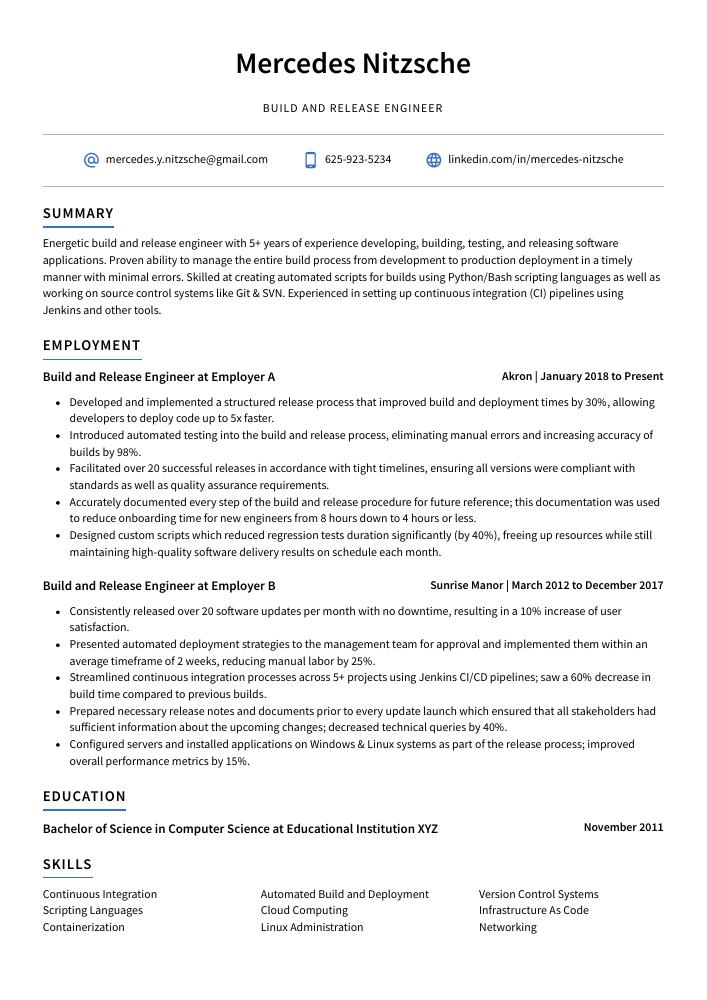Build and Release Engineer Resume Guide
Build and Release Engineers manage the process of building, testing, and releasing software. They are responsible for setting up automated build processes to ensure successful development, integration, and deployment of new software versions. Additionally, they monitor system performance post-release in order to identify any issues that may arise.
You have a knack for managing the build and release process of software applications, but employers won’t know that until you give them proof. To make sure hiring managers recognize your talents, you must craft an exceptional resume.
This guide will walk you through the entire process of creating a top-notch resume. We first show you a complete example and then break down what each resume section should look like.
Table of Contents
The guide is divided into sections for your convenience. You can read it from beginning to end or use the table of contents below to jump to a specific part.
Build and Release Engineer Resume Sample
Mercedes Nitzsche
Build and Release Engineer
[email protected]
625-923-5234
linkedin.com/in/mercedes-nitzsche
Summary
Energetic build and release engineer with 5+ years of experience developing, building, testing, and releasing software applications. Proven ability to manage the entire build process from development to production deployment in a timely manner with minimal errors. Skilled at creating automated scripts for builds using Python/Bash scripting languages as well as working on source control systems like Git & SVN. Experienced in setting up continuous integration (CI) pipelines using Jenkins and other tools.
Experience
Build and Release Engineer, Employer A
Akron, Jan 2018 – Present
- Developed and implemented a structured release process that improved build and deployment times by 30%, allowing developers to deploy code up to 5x faster.
- Introduced automated testing into the build and release process, eliminating manual errors and increasing accuracy of builds by 98%.
- Facilitated over 20 successful releases in accordance with tight timelines, ensuring all versions were compliant with standards as well as quality assurance requirements.
- Accurately documented every step of the build and release procedure for future reference; this documentation was used to reduce onboarding time for new engineers from 8 hours down to 4 hours or less.
- Designed custom scripts which reduced regression tests duration significantly (by 40%), freeing up resources while still maintaining high-quality software delivery results on schedule each month.
Build and Release Engineer, Employer B
Sunrise Manor, Mar 2012 – Dec 2017
- Consistently released over 20 software updates per month with no downtime, resulting in a 10% increase of user satisfaction.
- Presented automated deployment strategies to the management team for approval and implemented them within an average timeframe of 2 weeks, reducing manual labor by 25%.
- Streamlined continuous integration processes across 5+ projects using Jenkins CI/CD pipelines; saw a 60% decrease in build time compared to previous builds.
- Prepared necessary release notes and documents prior to every update launch which ensured that all stakeholders had sufficient information about the upcoming changes; decreased technical queries by 40%.
- Configured servers and installed applications on Windows & Linux systems as part of the release process; improved overall performance metrics by 15%.
Skills
- Continuous Integration
- Automated Build and Deployment
- Version Control Systems
- Scripting Languages
- Cloud Computing
- Infrastructure As Code
- Containerization
- Linux Administration
- Networking
Education
Bachelor of Science in Computer Science
Educational Institution XYZ
Nov 2011
Certifications
Certified Jenkins Engineer
CloudBees
May 2017
1. Summary / Objective
Your resume summary/objective should provide the hiring manager with a concise overview of your experience and qualifications as a build and release engineer. Include details such as the number of years you have been in this role, any certifications or awards you may have earned, and how successful your implementations have been. You can also mention specific tools/technologies that you are proficient in using to create efficient builds for software releases.
Below are some resume summary examples:
Enthusiastic build and release engineer with 5+ years of experience creating and managing build pipelines for software development projects. Proven ability to automate processes, improve efficiency, and ensure product quality. Experienced in working on a wide range of technologies such as Gitlab CI/CD, Jenkins, Docker Compose, Kubernetes & Helm Charts. Looking to join ABC Tech to help create robust automated solutions that streamline the delivery process for cutting-edge products.
Reliable build and release engineer with over 5 years of experience in automating the software development life cycle. Experienced in building, deploying, and releasing applications using various build tools such as Jenkins, Maven, Ant, etc. At XYZ Company successfully implemented a CI/CD pipeline for 10 different projects resulting in increased efficiency by 30%. Possess excellent problem-solving skills to resolve any issues related to DevOps automation processes quickly.
Passionate build and release engineer with 5+ years of experience in the software industry. Aiming to join ABC Tech’s engineering team as a build and release engineer, leveraging expertise in continuous integration (CI), continuous delivery (CD), DevOps culture automation, scripting languages, source control systems, deployment tools, and more. At XYZ Inc., improved deployment time from 4 days to 2 hours by implementing automated processes for testing and releasing code.
Professional build and release engineer with 7+ years of experience optimizing build pipelines, supporting DevOps initiatives, and ensuring software delivery accuracy. Demonstrated success in leading teams to develop automated CI/CD systems that improve scalability. Looking to join ABC Tech to continue my career as a build and release engineer where I can use my expertise in cloud technologies and scripting languages for further development opportunities.
Hard-working build and release engineer with 8+ years of experience developing, administering, and automating software builds in a fast-paced environment. Committed to minimizing downtime while optimizing the build process lifecycle through continual improvement initiatives. Recently implemented an automated CI/CD system that shortened development cycles by 25%. Seeking to join ABC Tech’s DevOps team as their next Build & Release Engineer.
Proficient Build and Release Engineer with 5+ years of experience in the software development life cycle. Experienced in using build automation tools such as Jenkins, Bamboo, and Ansible to improve release cycles. At XYZ Company implemented a CI/CD framework that decreased total time spent on builds by 30%. Skilled at creating custom scripts for automated deployments across multiple environments while ensuring optimal performance.
Talented build and release engineer with 5+ years of experience in the software development industry, specializing in automation. Skilled at creating scripts to manage and maintain reliable builds of product versions using various CI/CD tools such as Jenkins, Gitlab, CircleCI, etc. Experienced in debugging build failures and resolving them quickly to ensure timely delivery of products without any defects or errors.
Accomplished Build and Release Engineer with 5+ years of experience developing, testing, and deploying software products. Skilled in automation tools such as Jenkins and Puppet to streamline the development process from source control to production environments. Looking forward to joining ABC Tech where I can use my expertise in build engineering for improved product delivery cycles.
2. Experience / Employment
In the experience section, you should list your employment history in reverse chronological order. This means that the most recent job is listed first.
Stick to bullet points when writing this section; doing so allows the reader to quickly take in what you have to say without having to read through long paragraphs of text. When writing each point, provide detail on what tasks were completed and any results achieved as a result of those tasks.
For example, instead of saying “Developed software release process,” you could say, “Created an automated build-and-release process for new software releases which reduced deployment time by 40%.”
To write effective bullet points, begin with a strong verb or adverb. Industry specific verbs to use are:
- Automated
- Configured
- Monitored
- Optimized
- Implemented
- Integrated
- Developed
- Deployed
- Refactored
- Tested
- Debugged
- Troubleshot
- Resolved
- Packaged
- Released
Other general verbs you can use are:
- Achieved
- Advised
- Assessed
- Compiled
- Coordinated
- Demonstrated
- Expedited
- Facilitated
- Formulated
- Improved
- Introduced
- Mentored
- Participated
- Prepared
- Presented
- Reduced
- Reorganized
- Represented
- Revised
- Spearheaded
- Streamlined
- Structured
- Utilized
Below are some example bullet points:
- Integrated automated build and release processes for customer-facing applications, reducing release time by 30% and increasing scalability.
- Optimized existing testing frameworks to reduce errors encountered during releases, resulting in a 15% decrease of failed builds over the past year.
- Debugged complex issues related to version control systems such as Git & Mercurial; identified root causes of problems quickly and prevented future occurrences from arising with 75% accuracy rate or higher.
- Automated deployment pipelines into Amazon Web Services (AWS) using Jenkins scripting language; achieved zero manual intervention on post-deployment tasks within 2 weeks of implementation.
- Independently developed new tools that improved software delivery process efficiency by 10%, allowing developers more time to focus on innovation instead of manual troubleshooting activities.
- Demonstrated expertise in build and release engineering, streamlining the process of software releases by 22% while reducing deployment time from 48 hours to 8.
- Packaged applications for different platforms such as Windows, Mac OS X & Linux using automated packaging tools; optimized package size and ensured high-quality performance on each platform.
- Competently managed the entire software build cycle including code compilation, linking & pre-release testing with a focus on maintaining consistent quality standards across all builds.
- Assessed existing development processes against best practices then developed plans to improve efficiency through automation; reduced manual errors by 45%.
- Advised team members on source control management strategies such as branching/merging techniques and versioning policies that facilitated smoother collaboration between teams.
- Tested and verified software builds across all development environments to ensure quality and performance; successfully identified and resolved over 300 bugs in the last year.
- Reorganized build processes by introducing automation tools, resulting in a 20% reduction of manual labor hours allocated to release cycles within 6 months.
- Participated actively in deployment planning sessions with IT teams, as well as conducted detailed technical reviews for every scheduled project release for smooth execution on time and budgeted costs.
- Resolved critical environment issues quickly using advanced debugging techniques such as memory dumps & call traces which minimized downtime from 3 hours to 30 minutes on average per incident reported during deployments/upgrades/migrations this past quarter.
- Confidently recommended the use of various open-source applications that met user requirements while addressing security concerns; implemented these solutions across 5+ projects leading to improved system scalability by 25%.
- Expedited the build and release process for over 50 web applications, reducing time to deployment by 40%.
- Reliably automated the integration of code changes into existing software systems; streamlined processes with Bash scripts that saved 10 hours per week in manual labor.
- Deployed production-ready builds on a daily basis after rigorous testing and quality assurance reviews; successfully launched 15+ projects within tight deadlines this year.
- Compiled detailed documentation regarding build & release operations which enabled other departments to quickly identify any issues or problems arising from deployments; improved overall product support services by 30%.
- Mentored 5 junior engineers across all aspects of Build & Release engineering, providing guidance on best practices such as version control systems and continuous delivery pipelines; increased team efficiency by 20%.
- Spearheaded the building and releasing of 40+ software packages for clients each month, ensuring that releases were completed on schedule with no downtime.
- Revised the build and release process to improve automation efficiency by 25%, resulting in a cost savings of $5,000 annually.
- Reduced manual intervention in the testing phase by 50% through automated unit test frameworks; decreased bug fixing time from 10 hours to 4 hours per project.
- Substantially improved system reliability through frequent monitoring and troubleshooting activities; prevented potential outages due to technical failure or programming errors on 8 occasions within 1 year span at company ABCD Incorporated.
- Improved documentation accuracy across all projects released over a 3-year period; helped reduce development time for future products/features by 20%.
- Represented the software engineering team in the release of 7 major product updates, ensuring all builds met customer requirements and quality standards.
- Effectively managed the codebase for 10+ projects by configuring build tools such as Maven and Jenkins; improved build speed by 30% over a 6-month period.
- Achieved zero production downtime when deploying releases to customers, due to careful planning and scheduling of deployments across multiple environments.
- Coordinated with development teams during each phase of the application lifecycle, from development through testing, deployment and maintenance; reduced debugging time per project by 40%.
- Troubleshot issues related to builds or releases quickly & efficiently using debugging techniques such as log analysis & root cause identification; resolved 95% of incidents within 2 hours on average.
- Released over 200 software builds, deploying code to development and production environments in a timely manner while ensuring quality standards were met.
- Formulated release processes that streamlined deployment times by 15% while also reducing post-release errors by 10%.
- Refactored existing build scripts to improve efficiency, resulting in an average time savings of 45 minutes per build cycle.
- Implemented automated testing tools for all new releases; successfully identified and fixed over 50 bugs prior to customer rollout with zero reported issues afterwards.
- Successfully delivered critical updates on schedule without any delays or data loss incidents across multiple platforms including Windows, Linux & macOS systems.
3. Skills
Two organizations that have advertised for a position with the same title may be searching for individuals whose skills are quite different. For instance, one might require the candidate to be familiar with Jenkins and another Ansible.
It is essential that you tailor your skills section of your resume for each job you are applying for, as many employers use applicant tracking systems these days. These computer programs scan resumes for certain keywords before passing them on to a human; therefore, it’s important to ensure that yours contains all the required ones.
Once listed here, it would also be beneficial if you could discuss some of your most impressive skills in more detail in other areas such as the summary or experience sections.
Below is a list of common skills & terms:
- Automated Build and Deployment
- Cloud Computing
- Containerization
- Continuous Integration
- Infrastructure As Code
- Linux Administration
- Networking
- Scripting Languages
- Security Best Practices
- Version Control Systems
4. Education
Including an education section on your resume will depend on how far along you are in your career. If you have just graduated and have no work experience, list your education below the resume objective. However, if you’ve been working as a build and release engineer for years with plenty of accomplishments to showcase, omitting the education section is perfectly fine.
If an education section is included, try to mention courses or subjects related to the build and release engineer role that could help demonstrate why you would be a great fit for this position.
Bachelor of Science in Computer Science
Educational Institution XYZ
Nov 2011
5. Certifications
Certifications demonstrate to a potential employer that you are knowledgeable and experienced in a particular field. They can also show that you have taken the initiative to further your professional development by taking courses or attending seminars related to the job.
Including certifications on your resume is an excellent way of demonstrating your commitment and dedication towards staying up-to-date with industry trends, as well as showing off any specialized skills you may possess.
Certified Jenkins Engineer
CloudBees
May 2017
6. Contact Info
Your name should be the first thing a reader sees when viewing your resume, so ensure its positioning is prominent. Your phone number should be written in the most commonly used format in your country/city/state, and your email address should be professional.
You can also choose to include a link to your LinkedIn profile, personal website, or other online platforms relevant to your industry.
Finally, name your resume file appropriately to help hiring managers; for Mercedes Nitzsche, this would be Mercedes-Nitzsche-resume.pdf or Mercedes-Nitzsche-resume.docx.
7. Cover Letter
Including a cover letter in your job application is a great way to show potential employers that you are serious about the role. It gives them an opportunity to learn more about who you are and why they should consider hiring you, beyond what’s already included in your resume.
Cover letters typically include 2-4 paragraphs detailing how your skills match the requirements of the position, as well as any other information that may not be covered on a resume. Writing one can help set yourself apart from other candidates and demonstrate enthusiasm for the role.
Below is an example cover letter:
Dear Manuel,
I am interested in the Build and Release Engineer position at Facebook. With experience in automating release processes, managing code repositories, and writing custom scripts to optimize builds, I am confident I can contribute to the success of your organization.
In my current role as a Build and Release Engineer at Google, I manage code repositories for multiple projects, write custom scripts to optimize builds, and work with developers to automate release processes. I have experience working with a variety of build tools (e.g., Jenkins, Maven) and version control systems (e.g., Git), which makes me confident I can quickly adapt to new technologies and workflows.
I am also familiar with best practices for monitoring builds and deployments (e.g., using Nagios), which helps ensure that problems are identified and resolved quickly. In addition, I have strong problem-solving skills that come in handy when troubleshooting build or deployment issues.
The combination of my technical skillset, hands-on experience managing code repositories and builds/releases, makes me confident I will be an asset to your team. I look forward to speaking with you about this opportunity soon. Thank you for your time & consideration!
Sincerely,
Mercedes
Build and Release Engineer Resume Templates
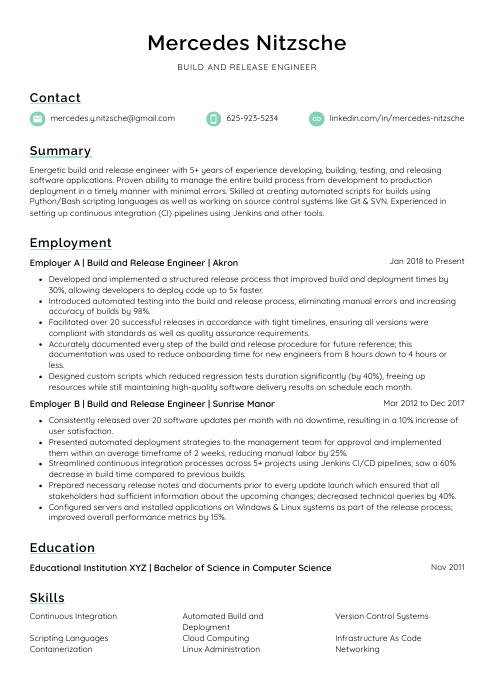 Lorikeet
Lorikeet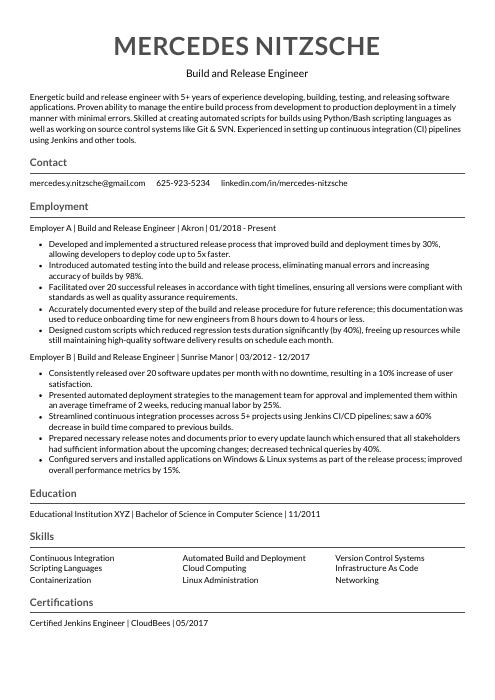 Indri
Indri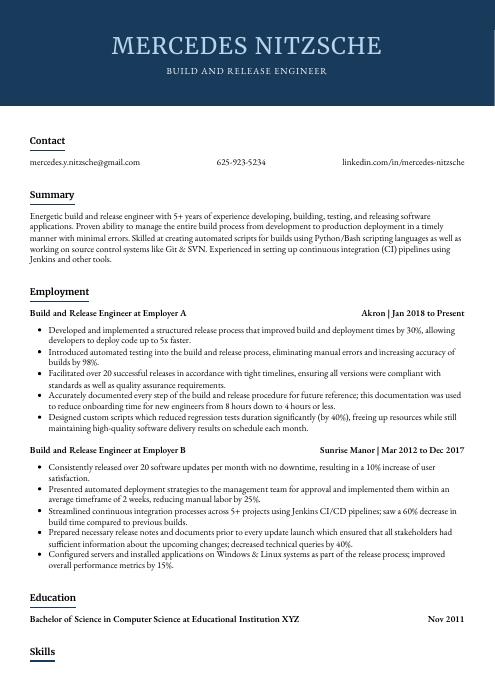 Bonobo
Bonobo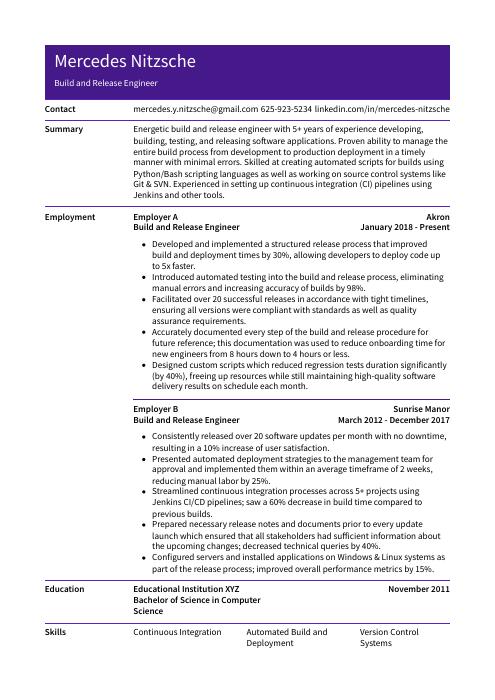 Pika
Pika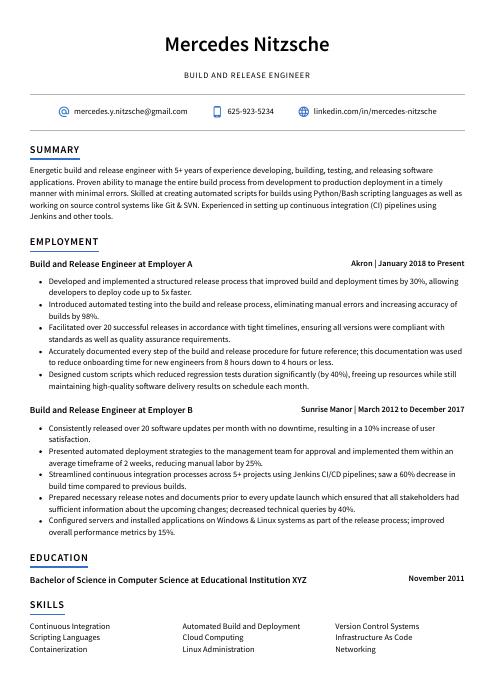 Axolotl
Axolotl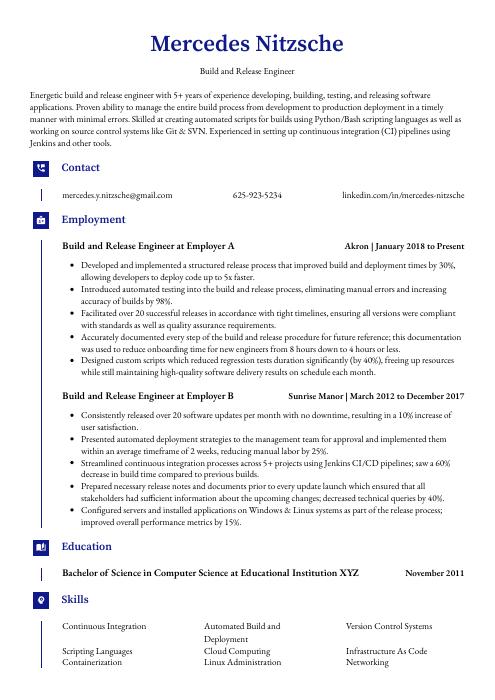 Gharial
Gharial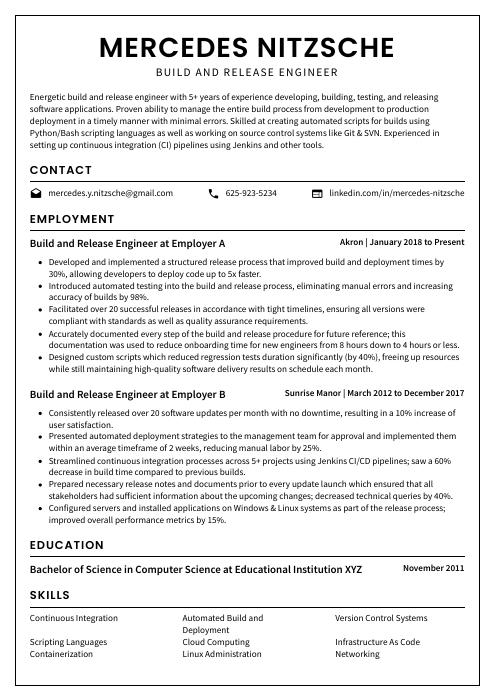 Cormorant
Cormorant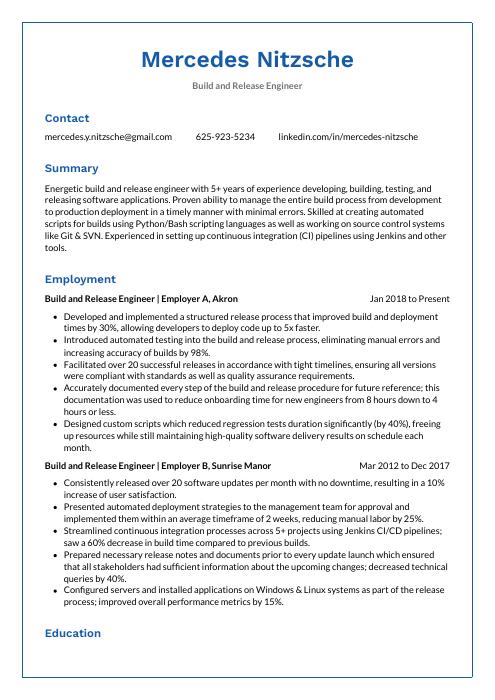 Markhor
Markhor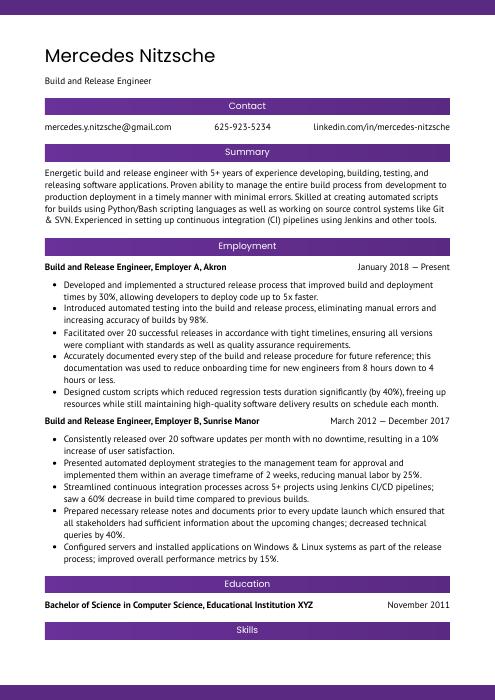 Jerboa
Jerboa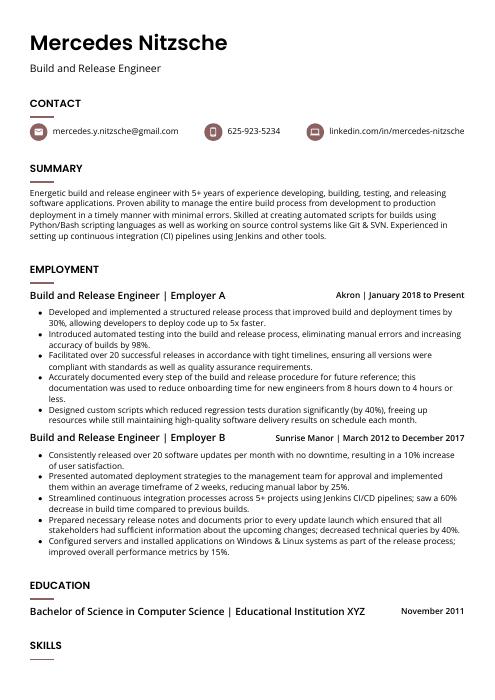 Fossa
Fossa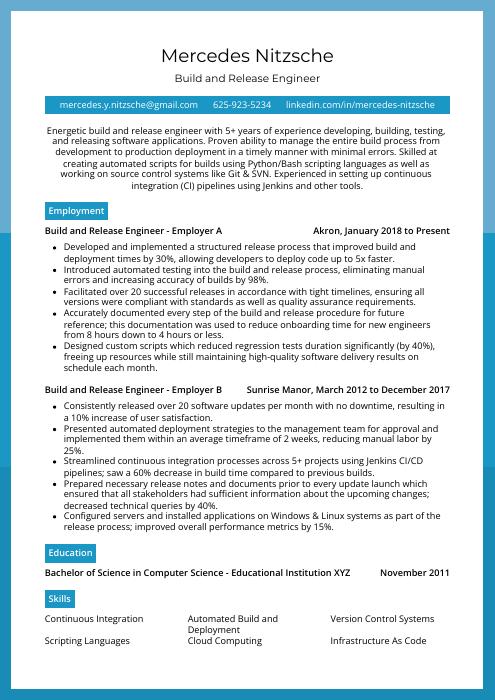 Rhea
Rhea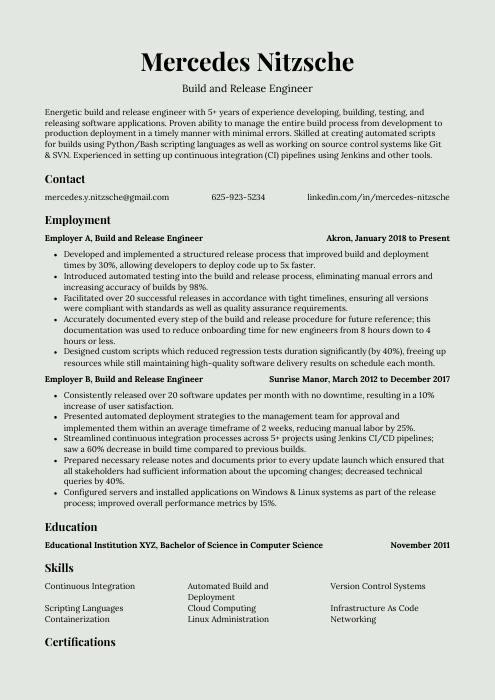 Saola
Saola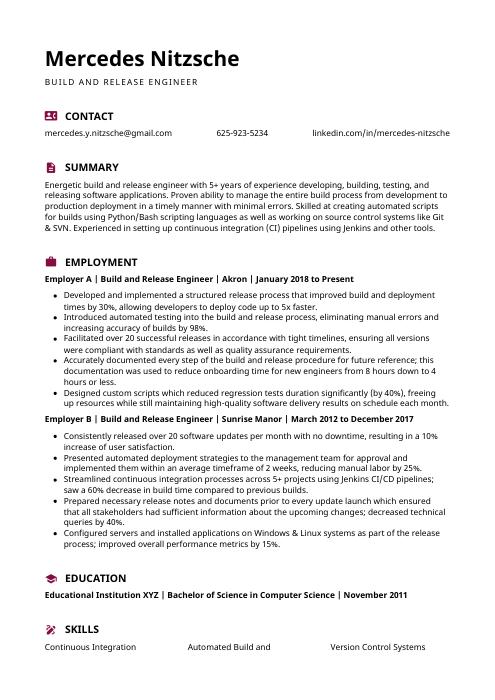 Hoopoe
Hoopoe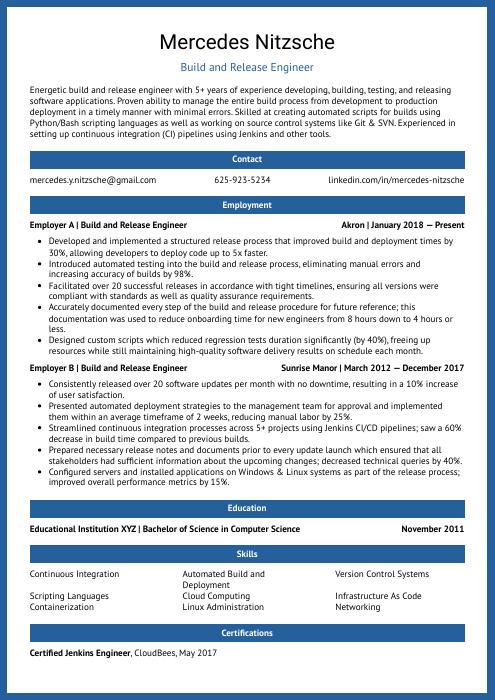 Ocelot
Ocelot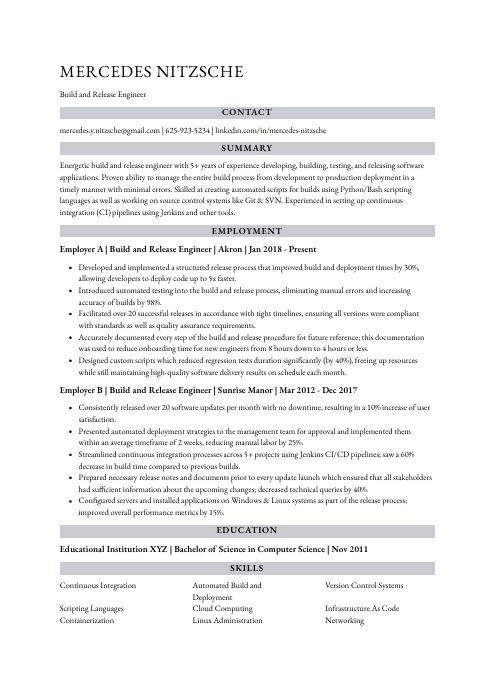 Numbat
Numbat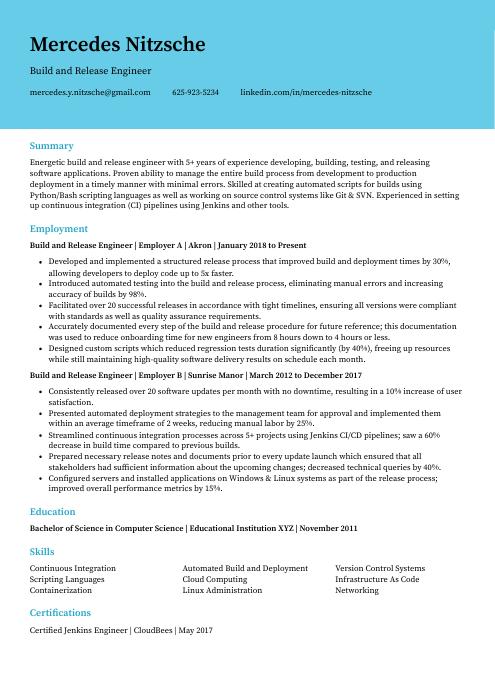 Dugong
Dugong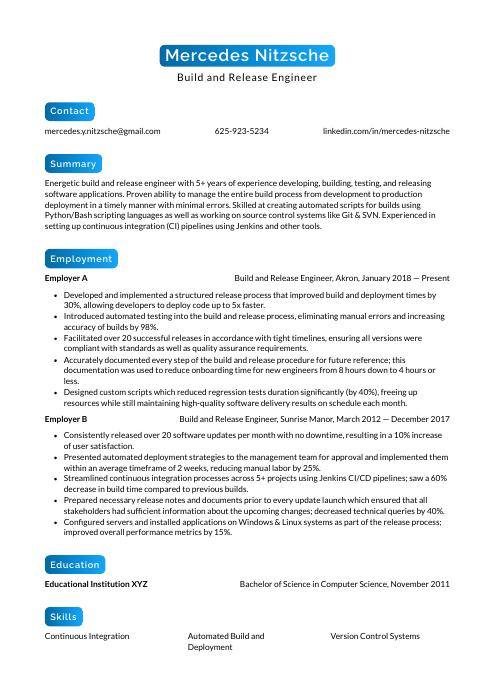 Kinkajou
Kinkajou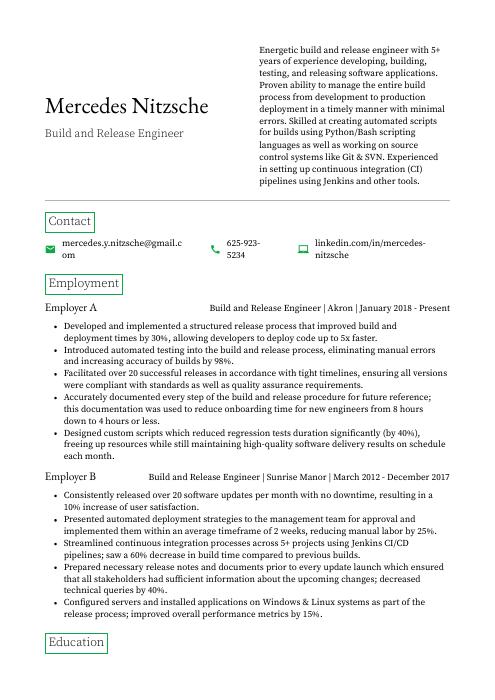 Quokka
Quokka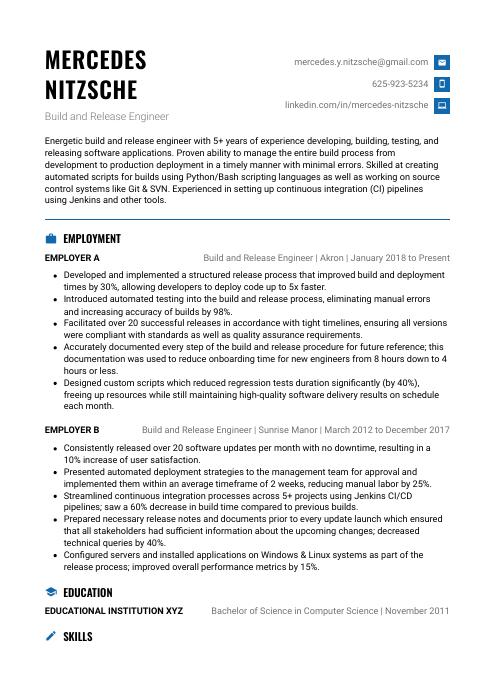 Echidna
Echidna Rezjumei
Rezjumei
